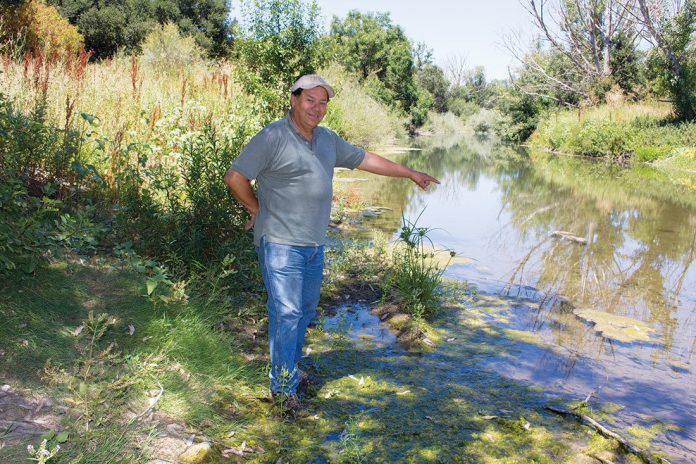
In a move that could impact communities statewide and save billions of gallons of water, a top Sacramento official will investigate the reported waste of massive amounts of water by the Santa Clara Valley Water District and others.
John Laird, California Secretary for Natural Resources, promised the probe on July 5 during a meeting with Herman Garcia of Gilroy.
“As a result of last week’s meeting, we are looking into this issue. We have not completed our fact finding on this,” said Sam Chui, a spokesman for the state natural resources agency. “We are happy to reach out to you once we have,” he added.
Garcia, who traveled to Sacramento to urge an investigation and a change in current law, is the founding president and CEO of the Gilroy-based Coastal Habitat Restoration and Environmental Education, or CHEER.
The conservation nonprofit restores and protects waterways and steelhead trout in the four-county Pajaro River Watershed.
Garcia discovered the waste situation last October, when massive amounts of water were released from Uvas Reservoir after a pre-wet season, three-day rainstorm drenched South County.
Flanked by State Assemblywoman Anna Caballero of Salinas, who arranged the meeting and chairs the State Assembly Committee on Agriculture, Garcia let Laird in on what he believes is one of the state’s dirtiest little secrets when it comes to water conservation.
The same folks who sell us water and spend millions of dollars of taxpayer money to build dams and urge conservation are actually required by legally binding agreements to spew possibly millions of acre-feet of fresh water into the ocean each year, according to Garcia. An acre-foot is 325,851 gallons.
And it has been going on for 60 years, ever since 1957, he says.
That is when the Santa Clara Valley Water District and water agencies statewide signed agreements that prohibit them from collecting water in reservoirs before Nov. 1 of each year, the official start of the rainy season, according to the CHEER leader.
What that means, he says, is that any water that accumulates in reservoirs after the dry season and before Nov. 1, for example from an early rain, must be discharged into the streams and rivers that carry it to the ocean.
South County and other parts of the state had just such a rainstorm over a three-day period in mid-October 2016. It resulted in massive new water collections behind local dams, such as the Uvas Dam outside Gilroy. And it’s what alerted Garcia to the problem.
The old agreement covers every earthen dam in the state that does not produce power, including 10 in the SCVWD, according to Garcia.
“They are still operating under agreements that have never been amended or modified to take us into the 21st Century, but everything has changed (over the years), there’s more development, more growth and more impacts on our water supply,” Garcia said.
The cost of six decades of flushing perfectly good water into the ocean has been “Millions if not hundreds of millions of dollars to taxpayers in higher water rates and higher taxes to build more dams and canals,” says Garcia.
A better approach is “common sense solutions,” he said. “Let’s go back and review all the old agreements and policies so they work for the 21st Century.”
That Laird’s office is looking into the matter is a welcome development, according to Garcia, not the least of reasons being that the state’s top natural resources official is from Santa Cruz and used to represent a huge portion of the Pajaro River Watershed.
Laird served for nine years as a Santa Cruz City Councilman in the 1980s, was the city’s mayor for two terms and was elected three times to the state assembly from the 27th District before being termed out and losing a bid for the state senate.
During his legislative tenure, he served as the chair of the assembly budget committee. A long-time conservationist, Laird was appointed to head the natural resources agency by Gov. Jerry Brown in January 2011.
If the agreements as written statewide mean water is being wasted, Garcia says he is confident Laird will fix the problem.
At the Santa Clara Valley Water District, spokesman Marty Grimes and Linda Arluck, who specializes in water agreements, confirmed Garcia’s fears.
“That flow in October was released because we don’t have the permitted right to impound (collect and keep) water until November first,” Grimes said.
Those rights are limited by other needs for the water, for example for wildlife, and the district is not allowed to keep all the water that collects in its reservoirs, he said.
Arluck said she believes the original Uvas Reservoir agreement was signed in 1955 and that it was updated with the state Department of Fish and Wildlife in 2010.
Regardless, they agreed, under the agreement the district’s permit to impound water stipulates that any water that collects in Uvas Reservoir before Nov. 1 must be released into Uvas Creek.
Such agreements vary depending on the reservoir, Arluck said.
At the time of Garcia’s October observations, the Uvas was about 35 percent full and did not reach capacity until Jan, 5 of this year, when it began to spill over and continued to spill until May, Grimes said.
Garcia, whose knowledge of local water matters is encyclopedia, was himself caught off guard when he learned quite by accident about the agreement and what he views as an unforgivable waste of water.
During the October storm, Garcia says he received a call from an official of the National Oceanographic and Atmospheric Administration, which monitors water flows to the ocean and works closely with CHEER.
As Garcia relates the story, the official, Joel Casagrande, asked him to check on flows in Uvas Creek at Silva’s Crossing, near the entrance to Christmas Hill Park in Gilroy. Post-storm measurements had put the flow at 1,600 cubic feet per second, or cfs, he told Garcia, a heavy flow for that time of year.
Garcia found that the tributaries of the Uvas all were dumping huge amounts of water into the creek, expected runoff from the big storm but not enough to account for the 1,600 cfs flow, he knew.
Between Garcia and Casagrande, they determined that Uvas Reservoir had collected about 1,000 acre-feet of new water from the storm, and was releasing 60 cfs into Uvas Creek during what was still, officially, a state-declared drought.
“I know that 60 cfs is 120 acre-feet of water per day, so if they are dumping 60 cfs for 10 days or more, there goes our one thousand acre-feet that we just gained, it’s all blown into Monterey Bay at a time when the governor is screaming conservation, and saying taxes will to up and water rates will go up and that brown is the new green,” Garcia said.
“We have big disaster in California because we have no water and at the same time they are dumping all this new water we collected into the ocean.”
Garcia was incredulous. And that, he said, is when Casagrande told him it was not the water district’s fault, that they were required by an agreement signed when the dam was built to release any new water collected in the reservoir before Nov. 1.
CHEER and Garcia have been on the forefront of habit, fishery and water conservation in South County and beyond since its founding in the late 1990s when Garcia and others discovered that pollution had all but wiped out he once thriving steelhead population throughout the 1,300 square mile watershed that encompasses all or parts of Santa Clara, Santa Cruz, Monterey and San Benito counties.
The all-volunteer group also regularly cleans creeks and their banks of garbage and debris that includes tires, cars, boats, old computers and more. Volunteers also clear waterways of natural blockages that occur when storms send limbs and whole trees cascading downstream and into tangled masses of vegetation that block water flows and fish runs, endangering the spawning season. And, when creeks start to dry up in the summer, volunteers help Garcia wade into deep, isolated pools to rescue steelhead fry and bring them to the Pajaro River.
Last year, CHEER hired an attorney and launched and pitched an angry battle against PG&E’s plans to build a power substation in South County, possibly near a creek that’s home to the federally protected steelhead and other endangered species.
PG&E shelved the plan after the public outcry and following a state power agency decision to restudy future power needs.
Now, CHEER is focused on changing the law and agreements with water districts so that they stop wasting the resource that were created to conserve and distribute wisely, according to Garcia.











